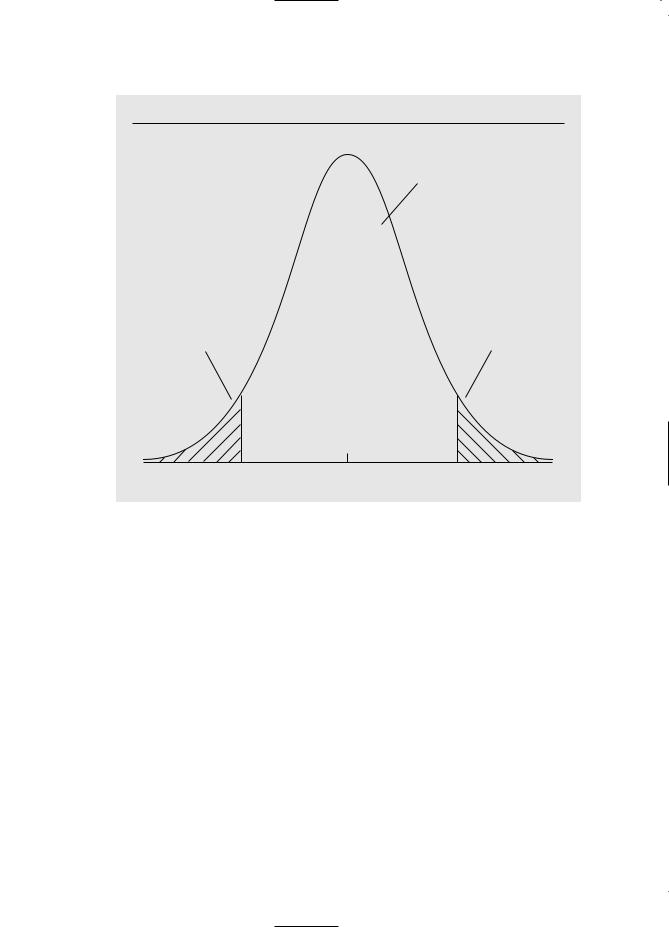
Wooldridge_-_Introductory_Econometrics_2nd_Ed
.pdf
Part 1 Regression Analysis with Cross-Sectional Data
F i g u r e 4 . 6
Obtaining the p-value against a two-sided alternative, when t 1.85 and df 40.
area = .9282
area = .0359 |
area = .0359 |
–1.85 0 1.85
In the example with df 40 and t 1.85, the p-value is computed as
p-value P( T 1.85) 2P(T 1.85) 2(.0359) .0718,
where P(T 1.85) is the area to the right of 1.85 in a t distribution with 40 df. (This value was computed using the econometrics package Stata; it is not available in Table G.2.) This means that, if the null hypothesis is true, we would observe an absolute value of the t statistic as large as 1.85 about 7.2% of the time. This provides some evidence against the null hypothesis, but we would not reject the null at the 5% significance level.
The previous example illustrates that once the p-value has been computed, a classical test can be carried out at any desired level. If denotes the significance level of the test (in decimal form), then H0 is rejected if p-value ; otherwise H0 is not rejected at the 100 % level.
Computing p-values for one-sided alternatives is also quite simple. Suppose, for example, that we test H0: j 0 against H1: j 0. If ˆj 0, then computing a p-value is not important: we know that the p-value is greater than .50, which will never cause
ˆ |
0, then t 0 and the p-value is just the probabil- |
us to reject H0 in favor of H1. If j |
ity that a t random variable with the appropriate df exceeds the value t. Some regression packages only compute p-values for two-sided alternatives. But it is simple to obtain the one-sided p-value: just divide the two-sided p-value by 2.
130

Chapter 4 |
|
|
Multiple Regression Analysis: Inference |
|
|
|
ˆ |
If the alternative is H1: j 0, it makes sense to compute a p-value if j 0 (and |
|||
hence t 0): p-value P(T t ) P(T |
t ) because the t distribution is symmetric |
||
about zero. Again, this can be obtained as one-half of the p-value for the two-tailed test. |
|||
|
|
|
Because you will quickly become |
|
|
|
familiar with the magnitudes of t statistics |
Q U E S T I O N |
4 . 3 |
|
|
|
that lead to statistical significance, espe- |
||
|
ˆ |
|
cially for large sample sizes, it is not |
Suppose you estimate a regression model and obtain 1 .56 and |
|
||
p-value .086 for testing H0: 1 0 against H1: 1 0. What is the |
|
always crucial to report p-values for t sta- |
|
p-value for testing H0: 1 0 against H1: 1 |
0? |
|
tistics. But it does not hurt to report them. |
|
|||
Further, when we discuss F testing in Section 4.5, we will see that it is important to compute p-values, because critical values for F tests are not so easily memorized.
A Reminder on the Language of Classical Hypothesis
Testing
When H0 is not rejected, we prefer to use the language “we fail to reject H0 at the x% level,” rather than “H0 is accepted at the x% level.” We can use Example 4.5 to illustrate why the former statement is preferred. In this example, the estimated elasticity of price
with respect to nox is .954, and the t statistic for testing H0: nox 1 is t .393; therefore, we cannot reject H0. But there are many other values for nox (more than we
can count) that cannot be rejected. For example, the t statistic for H0: nox .9 is ( .954 .9)/.117 .462, and so this null is not rejected either. Clearly nox 1 and nox .9 cannot both be true, so it makes no sense to say that we “accept” either of these hypotheses. All we can say is that the data do not allow us to reject either of these hypotheses at the 5% significance level.
Economic, or Practical, versus Statistical Significance
Since we have emphasized statistical significance throughout this section, now is a good time to remember that we should pay attention to the magnitude of the coefficient estimates in addition to the size of the t statistics. The statistical significance of a vari-
able x |
j |
is determined entirely by the size of t ˆ |
, whereas the economic significance or |
|||
|
|
|
|
j |
ˆ |
|
practical significance of a variable is related to the size (and sign) of j. |
||||||
Recall that the t statistic for testing H0: j |
0 is defined by dividing the estimate |
|||||
by its standard error: t ˆ |
ˆ |
ˆ |
|
|
||
|
/se( ). Thus, t ˆ can indicate statistical significance either |
|||||
|
|
j |
j |
j |
j |
|
|
|
ˆ |
|
|
ˆ |
|
because j is “large” or because se( j) is “small.” It is important in practice to distin-
guish between these reasons for statistically significant t statistics. Too much focus on statistical significance can lead to the false conclusion that a variable is “important” for explaining y even though its estimated effect is modest.
E X A M P L E 4 . 6
[ P a r t i c i p a t i o n R a t e s i n 4 0 1 ( k ) P l a n s ]
In Example 3.3, we used the data on 401(k) plans to estimate a model describing participation rates in terms of the firm’s match rate and the age of the plan. We now include a measure of firm size, the total number of firm employees (totemp). The estimated equation is
131

Part 1 |
Regression Analysis with Cross-Sectional Data |
praˆte (80.29) (5.44) mrate (.269) age (.00013) totemp
praˆte (0.78) (0.52) mrate (.045) age (.00004) totemp n 1,534, R2 .100.
The smallest t statistic in absolute value is that on the variable totemp: t .00013/.00004
3.25, and this is statistically significant at very small significance levels. (The two-tailed p-value for this t statistic is about .001.) Thus, all of the variables are statistically significant at rather small significance levels.
How big, in a practical sense, is the coefficient on totemp? Holding mrate and age fixed, if a firm grows by 10,000 employees, the participation rate falls by 10,000(.00013)
1.3 percentage points. This is a huge increase in number of employees with only a modest effect on the participation rate. Thus, while firm size does affect the participation rate, the effect is not practically very large.
The previous example shows that it is especially important to interpret the magnitude of the coefficient, in addition to looking at t statistics, when working with large samples. With large sample sizes, parameters can be estimated very precisely: standard errors are often quite small relative to the coefficient estimates, which usually results in statistical significance.
Some researchers insist on using smaller significance levels as the sample size increases, partly as a way to offset the fact that standard errors are getting smaller. For example, if we feel comfortable with a 5% level when n is a few hundred, we might use the 1% level when n is a few thousand. Using a smaller significance level means that economic and statistical significance are more likely to coincide, but there are no guarantees: in the the previous example, even if we use a significance level as small as .1% (one-tenth of one percent), we would still conclude that totemp is statistically significant.
Most researchers are also willing to entertain larger significance levels in applications with small sample sizes, reflecting the fact that it is harder to find significance with smaller sample sizes (the critical values are larger in magnitude and the estimators are less precise). Unfortunately, whether or not this is the case can depend on the researcher’s underlying agenda.
E X A M P L E 4 |
. 7 |
( E f f e c t o f J o b T r a i n i n g G r a n t s o n |
F i r m S c r a p R a t e s ) |
The scrap rate for a manufacturing firm is the number of defective items out of every 100 items produced that must be discarded. Thus, a decrease in the scrap rate reflects higher productivity.
We can use the scrap rate to measure the effect of worker training on productivity. For a sample of Michigan manufacturing firms in 1987, the following equation is estimated:
log(sˆcrap) (13.72) (.028) hrsemp (1.21) log(sales) (1.48) log(employ)
log(sˆcrap) (4.91) (.019) hrsemp (0.41) log(sales) (0.43) log(employ) n 30, R2 .431.
132

Chapter 4 |
Multiple Regression Analysis: Inference |
(This regression uses a subset of the data in JTRAIN.RAW.) The variable hrsemp is annual hours of training per employee, sales is annual firm sales (in dollars), and employ is number of firm employees. The average scrap rate in the sample is about 3.5, and the average hrsemp is about 7.3.
The main variable of interest is hrsemp. One more hour of training per employee lowers log(scrap) by .028, which means the scrap rate is about 2.8% lower. Thus, if hrsemp increases by 5—each employee is trained 5 more hours per year—the scrap rate is estimated to fall by 5(2.8) 14%. This seems like a reasonably large effect, but whether the additional training is worthwhile to the firm depends on the cost of training and the benefits from a lower scrap rate. We do not have the numbers needed to do a cost benefit analysis, but the estimated effect seems nontrivial.
What about the statistical significance of the training variable? The t statistic on hrsemp is .028/.019 1.47, and now you probably recognize this as not being large enough in magnitude to conclude that hrsemp is statistically significant at the 5% level. In fact, with
30 4 26 degrees of freedom for the one-sided alternative H1: hrsemp 0, the 5% critical value is about 1.71. Thus, using a strict 5% level test, we must conclude that hrsemp
is not statistically significant, even using a one-sided alternative.
Because the sample size is pretty small, we might be more liberal with the significance level. The 10% critical value is 1.32, and so hrsemp is significant against the one-sided alternative at the 10% level. The p-value is easily computed as P(T26 1.47) .077. This may be a low enough p-value to conclude that the estimated effect of training is not just due to sampling error, but some economists would have different opinions on this.
Remember that large standard errors can also be a result of multicollinearity (high correlation among some of the independent variables), even if the sample size seems fairly large. As we discussed in Section 3.4, there is not much we can do about this problem other than to collect more data or change the scope of the analysis by dropping certain independent variables from the model. As in the case of a small sample size, it can be hard to precisely estimate partial effects when some of the explanatory variables are highly correlated. (Section 4.5 contains an example.)
We end this section with some guidelines for discussing the economic and statistical significance of a variable in a multiple regression model:
1.Check for statistical significance. If the variable is statistically significant, discuss the magnitude of the coefficient to get an idea of its practical or economic importance. This latter step can require some care, depending on how the independent and dependent variables appear in the equation. (In particular, what are the units of measurement? Do the variables appear in logarithmic form?)
2.If a variable is not statistically significant at the usual levels (10%, 5% or 1%), you might still ask if the variable has the expected effect on y and whether that effect is practically large. If it is large, you should compute a p-value for the t statistic. For small sample sizes, you can sometimes make a case for p-values as large as .20 (but there are no hard rules). With large p-values, that is, small t statistics, we are treading on thin ice because the practically large estimates may be due to sampling error: a different random sample could result in a very different estimate.
133

Part 1 |
Regression Analysis with Cross-Sectional Data |
3.It is common to find variables with small t statistics that have the “wrong” sign. For practical purposes, these can be ignored: we conclude that the variables are statistically insignificant. A significant variable that has the unexpected sign and a practically large effect is much more troubling and difficult to resolve. One must usually think more about the model and the nature of the data in order to solve such problems. Often a counterintuitive, significant estimate results from the omission of a key variable or from one of the important problems we will discuss in Chapters 9 and 15.
4.3CONFIDENCE INTERVALS
Under the classical linear model assumptions, we can easily construct a confidence interval (CI) for the population parameter j. Confidence intervals are also called interval estimates because they provide a range of likely values for the population parameter, and not just a point estimate.
Using the fact that ( ˆj j)/se( ˆj) has a t distribution with n k 1 degrees of freedom [see (4.3)], simple manipulation leads to a CI for the unknown j. A 95% confidence interval, given by
ˆ |
ˆ |
(4.16) |
j c se( j), |
||
where the constant c is the 97.5th percentile in a tn k 1 distribution. More precisely, the lower and upper bounds of the confidence interval are given by
¯j ˆj c se( ˆj)
and
¯j ˆj c se( ˆj),
respectively.
At this point, it is useful to review the meaning of a confidence interval. If random
|
¯ |
samples were obtained over and over again, with j , and j computed each time, then |
|
¯ |
¯ |
the (unknown) population value j would lie in the interval ( ¯j , j ) for 95% of the samples. Unfortunately, for the single sample that we use to contruct the CI, we do not
know whether j is actually contained in the interval. We hope we have obtained a sample that is one of the 95% of all samples where the interval estimate contains j, but we have no guarantee.
Constructing a confidence interval is very simple when using current computing technology. Three quantities are needed: ˆj, se( ˆj), and c. The coefficient estimate and its standard error are reported by any regression package. To obtain the value c, we must know the degrees of freedom, n k 1, and the level of confidence—95% in this case. Then, the value for c is obtained from the tn-k-1 distribution.
As an example, for df n k 1 25, a 95% confidence interval for any j is given by [ ˆj 2.06 se( ˆj), ˆj 2.06 se( ˆj)].
When n k 1 120, the tn k 1 distribution is close enough to normal to use the 97.5th percentile in a standard normal distribution for constructing a 95% CI: ˆj 1.96 se( ˆj). In fact, when n k 1 50, the value of c is so close to 2 that we can
134

Chapter 4 |
Multiple Regression Analysis: Inference |
use a simple rule of thumb for a 95% confidence interval: ˆj plus or minus two of its standard errors. For small degrees of freedom, the exact percentiles should be obtained from the t tables.
It is easy to construct confidence intervals for any other level of confidence. For example, a 90% CI is obtained by choosing c to be the 95th percentile in the tn k 1 distribution. When df n k 1 25, c 1.71, and so the 90% CI is ˆj 1.71 se( ˆj), which is necessarily narrower than the 95% CI. For a 99% CI, c is the 99.5th percentile in the t25 distribution. When df 25, the 99% CI is roughly ˆj 2.79 se( ˆj), which is inevitably wider than the 95% CI.
Many modern regression packages save us from doing any calculations by reporting a 95% CI along with each coefficient and its standard error. Once a confidence interval is constructed, it is easy to carry out two-tailed hypotheses tests. If the null hypothesis is H0: j aj, then H0 is rejected against H1: j aj at (say) the 5% significance level if, and only if, aj is not in the 95% confidence interval.
E X A M P L E 4 . 8
( H e d o n i c P r i c e M o d e l f o r H o u s e s )
A model that explains the price of a good in terms of the good’s characteristics is called an hedonic price model. The following equation is an hedonic price model for housing prices; the characteristics are square footage (sqrft), number of bedrooms (bdrms), and number of bathrooms (bthrms). Often price appears in logarithmic form, as do some of the explanatory variables. Using n 19 observations on houses that were sold in Waltham, Massachusetts, in 1990, the estimated equation (with standard errors in parentheses below the coefficient estimates) is
log(pˆrice) (7.46) (.634) log(sqrft) (.066) bdrms (.158) bthrms
log(pˆrice) (1.15) (.184) log(sqrft) (.059) bdrms (.075) bthrms n 19, R2 .806.
Since price and sqrft both appear in logarithmic form, the price elasticity with respect to square footage is .634, so that, holding number of bedrooms and bathrooms fixed, a 1% increase in square footage increases the predicted housing price by about .634%. We can construct a 95% confidence interval for the population elasticity using the fact that the estimated model has n k 1 19 3 1 15 degrees of freedom. From Table G.2, we find the 97.5th percentile in the t15 distribution: c 2.131. Thus, the 95% confidence inter-
val for log(sqrft ) is .634 2.131(.184), or (.242,1.026). Since zero is excluded from this confidence interval, we reject H0: log(sqrft ) 0 against the two-sided alternative at the 5% level.
The coefficient on bdrms is negative, which seems counterintuitive. However, it is important to remember the ceteris paribus nature of this coefficient: it measures the effect of another bedroom, holding size of the house and number of bathrooms fixed. If two houses are the same size but one has more bedrooms, then the house with more bedrooms has smaller bedrooms; more bedrooms that are smaller is not necessarily a good thing. In
any case, we can see that the 95% confidence interval for bdrms is fairly wide, and it contains the value zero: .066 2.131(.059) or ( .192,.060). Thus, bdrms does not have a
statistically significant ceteris paribus effect on housing price.
135

Part 1 |
Regression Analysis with Cross-Sectional Data |
Given size and number of bedrooms, one more bathroom is predicted to increase housing price by about 15.8%. (Remember that we must multiply the coefficient on bthrms by
100 to turn the effect into a percent.) The 95% confidence interval for bthrms is ( .002,.318). In this case, zero is barely in the confidence interval, so technically speaking
ˆ is not statistically significant at the 5% level against a two-sided alternative. Since it
bthrms
is very close to being significant, we would probably conclude that number of bathrooms has an effect on log(price).
You should remember that a confidence interval is only as good as the underlying assumptions used to construct it. If we have omitted important factors that are correlated with the explanatory variables, then the coefficient estimates are not reliable: OLS is biased. If heteroskedasticity is present—for instance, in the previous example, if the variance of log(price) depends on any of the explanatory variables—then the standard error is not valid as an estimate of sd( ˆj) (as we discussed in Section 3.4), and the confidence interval computed using these standard errors will not truly be a 95% CI. We have also used the normality assumption on the errors in obtaining these CIs, but, as we will see in Chapter 5, this is not as important for applications involving hundreds of observations.
4.4 TESTING HYPOTHESES ABOUT A SINGLE LINEAR COMBINATION OF THE PARAMETERS
The previous two sections have shown how to use classical hypothesis testing or confidence intervals to test hypotheses about a single j at a time. In applications, we must often test hypotheses involving more than one of the population parameters. In this section, we show how to test a single hypothesis involving more than one of the j. Section
4.5shows how to test multiple hypotheses.
To illustrate the general approach, we will consider a simple model to compare the
returns to education at junior colleges and four-year colleges; for simplicity, we refer to the latter as “universities.” [This example is motivated by Kane and Rouse (1995), who provide a detailed analysis of this question.] The population includes working people with a high school degree, and the model is
log(wage) 0 1 jc 2univ 3exper u, |
(4.17) |
where jc is number of years attending a two-year college and univ is number of years at a four-year college. Note that any combination of junior college and college is allowed, including jc 0 and univ 0.
The hypothesis of interest is whether a year at a junior college is worth a year at a university: this is stated as
H0: 1 2. |
(4.18) |
Under H0, another year at a junior college and another year at a university lead to the same ceteris paribus percentage increase in wage. For the most part, the alternative of
136

Chapter 4 |
Multiple Regression Analysis: Inference |
interest is one-sided: a year at a junior college is worth less than a year at a university. This is stated as
H1: 1 2. |
(4.19) |
The hypotheses in (4.18) and (4.19) concern two parameters, 1 and 2, a situation we have not faced yet. We cannot simply use the individual t statistics for ˆ1 and ˆ2 to test H0. However, conceptually, there is no difficulty in constructing a t statistic for testing (4.18). In order to do so, we rewrite the null and alternative as H0: 1 2 0 and H1: 1 2 0, respectively. The t statistic is based on whether the estimated difference ˆ1 ˆ2 is sufficiently less than zero to warrant rejecting (4.18) in favor of (4.19). To account for the sampling error in our estimators, we standardize this difference by dividing by the standard error:
|
ˆ |
|
ˆ |
|
|
t |
1 |
2 |
. |
(4.20) |
|
ˆ |
|
ˆ |
|||
|
se( 1 |
2) |
|
|
|
Once we have the t statistic in (4.20), testing proceeds as before. We choose a significance level for the test and, based on the df, obtain a critical value. Because the alternative is of the form in (4.19), the rejection rule is of the form t c, where c is a positive value chosen from the appropriate t distribution. Or, we compute the t statistic and then compute the p-value (see Section 4.2).
The only thing that makes testing the equality of two different parameters more difficult than testing about a single j is obtaining the standard error in the denominator of (4.20). Obtaining the numerator is trivial once we have peformed the OLS regression. For concreteness, suppose the following equation has been obtained using n 285 individuals:
log(wˆage) 1.43 .098 jc .124 univ .019 exper |
|
log(wˆage) (0.27) (.031) jc (.035) univ (.008) exper |
(4.21) |
n 285, R2 .243. |
|
|
|
It is clear from (4.21) that jc and univ have both economically and statistically significant effects on wage. This is certainly of interest, but we are more concerned about testing whether the estimated difference in the coefficients is statistically significant. The difference is estimated as ˆ1 ˆ2 .026, so the return to a year at a junior college is about 2.6 percentage points less than a year at a university. Economically, this is not a trivial difference. The difference of .026 is the numerator of the t statistic in (4.20).
Unfortunately, the regression results in equation (4.21) do not contain enough information to obtain the standard error of ˆ1 ˆ2. It might be tempting to claim that se( ˆ1 ˆ2) se( ˆ1) se( ˆ2), but this does not make sense in the current example because se( ˆ1) se( ˆ2) .038. Standard errors must always be positive because they are estimates of standard deviations. While the standard error of the differenceˆ1 ˆ2 certainly depends on se( ˆ1) and se( ˆ2), it does so in a somewhat complicated way. To find se( ˆ1 ˆ2), we first obtain the variance of the difference. Using the results on variances in Appendix B, we have
137

Part 1 Regression Analysis with Cross-Sectional Data
ˆ |
ˆ |
ˆ |
ˆ |
ˆ ˆ |
(4.22) |
Var( 1 |
2) Var( 1) Var( 2) 2 Cov( 1, 2). |
||||
Observe carefully how the two variances are added together, and twice the covariance is then subtracted. The standard deviation of ˆ1 ˆ2 is just the square root of (4.22) and, since [se( ˆ1)]2 is an unbiased estimator of Var( ˆ1), and similarly for [se( ˆ2)]2, we have
ˆ |
ˆ |
ˆ |
2 |
ˆ |
2 |
2s12 |
1/ 2 |
, |
(4.23) |
se( 1 |
2) [se( 1)] |
|
[se( 2)] |
|
|
||||
where s12 denotes an estimate of Cov( ˆ1, ˆ2). We have not displayed a formula for Cov( ˆ1, ˆ2). Some regression packages have features that allow one to obtain s12, in which case one can compute the standard error in (4.23) and then the t statistic in (4.20). Appendix E shows how to use matrix algebra to obtain s12.
We suggest another route that is much simpler to compute, less likely to lead to an error, and readily applied to a variety of problems. Rather than trying to compute se( ˆ1 ˆ2) from (4.23), it is much easier to estimate a different model that directly delivers the standard error of interest. Define a new parameter as the difference between1 and 2: 1 1 2. Then we want to test
H0: 1 0 against H1: 1 0. |
(4.24) |
The t statistic (4.20) in terms of ˆ1 is just t ˆ1/se( ˆ1). The challenge is finding se( ˆ1). We can do this by rewriting the model so that 1 appears directly on one of the independent variables. Since 1 1 2, we can also write 1 1 2. Plugging this
into (4.17) and rearranging gives the equation
log(wage) 0 ( 1 2)jc 2univ 3exper u
0 1 jc 2( jc univ) 3exper u.
(4.25)
The key insight is that the parameter we are interested in testing hypotheses about, 1, now multiplies the variable jc. The intercept is still 0, and exper still shows up as being multiplied by 3. More importantly, there is a new variable multiplying 2, namely jc univ. Thus, if we want to directly estimate 1 and obtain the standard error ˆ1, then we must construct the new variable jc univ and include it in the regression model in place of univ. In this example, the new variable has a natural interpretation: it is total years of college, so define totcoll jc univ and write (4.25) as
log(wage) 0 1 jc 2totcoll 3exper u. |
(4.26) |
The parameter 1 has disappeared from the model, while 1 appears explicitly. This model is really just a different way of writing the original model. The only reason we have defined this new model is that, when we estimate it, the coefficient on jc is ˆ1 and, more importantly, se( ˆ1) is reported along with the estimate. The t statistic that we want is the one reported by any regression package on the variable jc (not the variable totcoll).
138

Chapter 4 Multiple Regression Analysis: Inference
When we do this with the 285 observations used earlier, the result is |
|
|
|
|
|
log(wˆage) 1.43 |
.026 jc .124 totcoll .019 exper |
|
log(wˆage) (0.27) |
(.018) jc (.035) totcoll (.008) exper |
(4.27) |
|
n 285, R2 .243. |
|
|
|
|
The only number in this equation that we could not get from (4.21) is the standard error for the estimate .026, which is .018. The t statistic for testing (4.18) is .026/.0181.44. Against the one-sided alternative (4.19), the p-value is about .075, so there is some, but not strong, evidence against (4.18).
The intercept and slope estimate on exper, along with their standard errors, are the same as in (4.21). This fact must be true, and it provides one way of checking whether the transformed equation has been properly estimated. The coefficient on the new variable, totcoll, is the same as the coefficient on univ in (4.21), and the standard error is also the same. We know that this must happen by comparing (4.17) and (4.25).
It is quite simple to compute a 95% confidence interval for 1 1 2. Using the standard normal approximation, the CI is obtained as usual: ˆ1 1.96 se( ˆ1), which in this case leads to .026 .035.
The strategy of rewriting the model so that it contains the parameter of interest works in all cases and is easy to implement. (See Problems 4.12 and 4.14 for other examples.)
4.5 TESTING MULTIPLE LINEAR RESTRICTIONS: THE F TEST
The t statistic associated with any OLS coefficient can be used to test whether the corresponding unknown parameter in the population is equal to any given constant (which is usually, but not always, zero). We have just shown how to test hypotheses about a single linear combination of the j by rearranging the equation and running a regression using transformed variables. But so far, we have only covered hypotheses involving a single restriction. Frequently, we wish to test multiple hypotheses about the underlying parameters 0 , 1 , …, k. We begin with the leading case of testing whether a set of independent variables has no partial effect on a dependent variable.
Testing Exclusion Restrictions
We already know how to test whether a particular variable has no partial effect on the dependent variable: use the t statistic. Now we want to test whether a group of variables has no effect on the dependent variable. More precisely, the null hypothesis is that a set of variables has no effect on y, once another set of variables has been controlled.
As an illustration of why testing significance of a group of variables is useful, we consider the following model that explains major league baseball players’ salaries:
log(salary) 0 1years 2gamesyr 3bavg
4hrunsyr 5rbisyr u,
(4.28)
139
